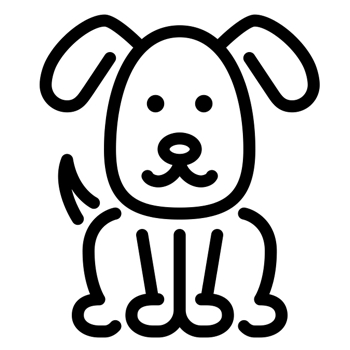Skypoo

A delightful little dog, the Skypoo, also known as the Skydoodle, is a smart dog that can be trained to a high standard and often has exceptional manners. Due to their small size and moderate exercise requirements, Skypoos are becoming increasingly popular in cities as apartment pets.
As both the parent breeds, Skye Terriers and Poodles, come in an array of colours, Skypoos exhibit a wide range of fur colours and shades. Possibly their most notable feature are their unusual ears, which generally resemble those of the Skye Terrier and tend to be covered in long, silky fur.
About & History
The Skypoo is one of those uncommon designer dog breeds that quietly came onto the scene and has yet to make a big name for itself. Due to this, not much is known about their history. While we know little about the recent past of the Skypoo, there is plenty to discuss when it comes to each of their parent breeds: the Poodle and Skye Terrier.
The Poodle
Poodles are versatile pedigrees that bring a lot to the table. Their personalities sparkle as they are generally intelligent, obedient and affectionate. On top of this, their fur tends to be hypoallergenic and easy to maintain. Combine these traits with the fact that the Poodle can come in three different sizes, it is little wonder that they are the breed most commonly used to create new hybrids.
Originally bred in Germany from local sheepdogs and hunting dogs, the Poodle was popularised in France where the high society took a shine to them and would groom them to a high standard and treat them as members of the family. Traditionally, Poodles were used to both hunt and to find truffles, so their scenting skills and ability to concentrate has always been vital. Nowadays, Poodles are mainly kept as pets but are often seen in both the show and agility ring. Indeed, these multi-purpose pooches also make good service dogs and can be used as hearing guide dogs, for example.
The Skye Terrier
Skye Terriers are an endangered breed nowadays but have been around for a long time, being one of the oldest Scottish dog breeds in existence. Their name comes from their place of origin – the isle of Skye in the Inner Hebrides. As with the Poodle, the Skye Terrier was used to hunt and would not only control vermin levels but would also pursue larger animals, such as foxes and rabbits.
Their short limbs allowed them good access to the ground and they were well-suited to finding wild animals’ dens and burrows. Those individuals that have survived to modern day are kept as pets and there are great efforts being made to increase the population size and prevent the breed from dying off completely.
Appearance
Skypoos have a sturdy appearance and while their body is long and their limbs are short, these characteristic traits are less pronounced than they are in the Skye Terrier thanks to the dilution of these genes through the addition of the Poodle into the bloodline. They have a relatively small head with a medium-length pointed muzzle and round, dark brown eyes. Their ears sit proudly atop their head and are widely spaced, either falling forward in a sprightly manner or standing erect. Their tail is quite long and curves slightly, covered in a thick plume of fur.
Most Skypoos will be bred from Miniature or Toy Poodles so will stand between 25cm and 38cm and weigh from 8kg to 18kg. Though many of the Skypoos bred tend to be cream or white, they can be a number of different colours, including black, red, blue and gray. While their coat can be long and wiry like the Skye Terrier or dense and curly like the Poodle, for most, their fur will lie somewhere in between these two options and is medium in length with some degree of curling.
Character & Temperament
A dog that enjoys being an integral part of the family, the Skypoo enjoys being close to the people it loves the most. They are highly social and affectionate, never one to shy away from attention. Gentle with everyone, the Skypoo makes a good companion for families with children.
Smart and curious, Skypoos have a real zest for life and are generally eager to please their masters, making well-behaved housemates. Their good nature makes them the ideal choice for those who have limited experience with dogs and their training, as they can make even a novice trainer look like a pro!
Ideally-suited to modern day life, Skypoos are happy to live in small spaces and do not necessarily need access to a garden. They are typically quiet and do not tend to bark incessantly, as can be an issue in other breeds. For these reasons, those living in apartments may find the Skypoo to be an ideal choice.
Trainability
Skypoos are great fun to train and can learn quickly with seemingly little effort. They are alert during their training sessions and have a good attention span. Owners should still be sure to be consistent in their training and should not rely too heavily on the intelligence of the Skypoo to make up for any training that may be lacking!
As is true of any dog, it’s incredibly important to socialise the Skypoo as early as possible to avoid them becoming anxious around people or pets. The more new things that they are exposed to in their first few months of life, the more well-rounded they will be once mature.
Health
Breeding two pedigrees together is a well-accepted method of producing a healthier population but this doesn’t mean that hybrid dogs are exempt from developing genetic health issues. The following can be more prevalent in the Skypoo population than in the general canine population:
Intervertebral Disc Disease
The long back of the Skypoo predisposes it to developing Intervertebral Disc Disease, or IVDD for short, throughout its life. There are three main types of this disease: Hansen Type One, Two and Three, but it is the Type One form of the disease that is seen in Skypoos. For most, symptoms develop suddenly when the inner contents of the disc herniate and impinge on the spinal cord.
Dogs experience a great deal of pain and may even lose the use of their limbs. Imaging studies are used to determine the extent of the injury and, depending on the severity of the lesion, animals will either be managed surgically or with conservative therapy.
Hepatitis
Chronic hepatitis does not always have a known cause though in the Skye Terrier in particular it can be associated with improper copper storage. Blood tests will reveal increased liver enzymes and the inflamed liver will be unable to perform its function as normal.
Von Willebrand Disease
A blood clotting disorder, affected dogs have a deficiency in their von Willebrand factor meaning platelets don’t stick together as they should to help prevent bleeding. Some dogs do not show many (if any) symptoms while others will bleed spontaneously from places, such as their nose. Those suspected to be prone to this condition should be screened for it, particularly before any events, such as an elective neutering surgery.
Exercise and Activity Levels
With moderate exercise needs, the Skypoo makes a good pet for those with a relatively sedentary lifestyle that may simply not have time available to go on long hikes and runs every day. One daily jaunt outside to the local green or park for 20 or 30 minutes or so is usually enough for the Skypoo.
On top of this, however, they should be provided with plenty of mental stimulation in the form of games and puzzles to prevent boredom from setting in. Always up for a game, owners can also supplement their exercise with fetch in the garden or games of chase with the children.
Grooming
One desirable feature of the Skypoo’s coat is that it should be hypoallergenic – although this can never be guaranteed. Owners should try to brush the coat through on a daily basis when possible as leaving it un-brushed for too long could result in uncomfortable tangles forming.
Those with ears that are pendulous should have their ear canals and pinnae inspected regularly and will likely require cleaning every one to two weeks. Ears must be dried thoroughly after swimming or bathing as increased moisture within the canal can lead to local infection.

